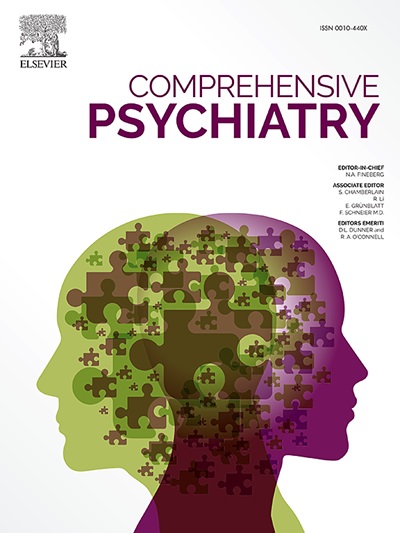在抑郁症、双相情感障碍和精神分裂症中导航物质使用和精神病理学的挑战
IF 4.2
2区 医学
Q1 PSYCHIATRY
引用次数: 0
摘要
处理物质使用障碍(sud)与精神病理条件,如重度抑郁症(MDD)、双相情感障碍(BD)和精神分裂症-通常被称为双重诊断或共发生的疾病-对患者和临床医生都提出了重大挑战,需要同时处理物质使用和精神病理的综合治疗方法。目的与方法本系统综述的目的是分析和总结各种双重诊断药物治疗的现有研究,全面了解其有效性并确定需要进一步探索的领域。该系统评价按照系统评价和荟萃分析(PRISMA)指南的首选报告项目进行构建,并在国际前瞻性系统评价登记册(PROSPERO)上注册,id号为CRD 42024500114。结果分析现有文献66篇,其中29篇与sud相关;精神分裂症,20岁,专注于sud;MDD和17个在sud上。BD:总的来说,大多数记录sud的手稿涉及以下药物:酒精(N = 26)、大麻(N = 19)、阿片类药物(N = 10)、可卡因(N = 10)和安非他明(N = 3),而一些研究描述了一般的sud (N = 12)。根据所记录的每一种主要情况的干预类型,以主题方式呈现研究结果。在精神病症状和sud的情况下,阿立哌唑似乎是维持治疗中最常用的药物,不仅因为它的有效性,而且因为它的安全性。另外,尽管有副作用,氯氮平在控制症状和预防复发方面表现出良好的疗效。此外,长效药物可能是控制冲动和精神病症状的有效选择,但也可用于首发精神病,减少复发和再住院。关于重度抑郁/双相障碍和sud的治疗,关于控制症状的最佳药物有不同的发现;值得注意的是,如果加入心理/行为干预措施,或与特定的SUD治疗(如阿片受体激动剂/拮抗剂治疗或抗谷氨酸能药物阿坎前列酸/美金刚等)联合使用,则记录到不同程度的疗效。结论目前的证据包括根据特定的精神病理,特定的SUD涉及,治疗环境,哪种药物在控制症状方面具有优势。护理的首要目标。总的来说,双重诊断的药物治疗是复杂的,考虑到人群的异质性,需要个性化的方法。未来的研究应侧重于制定个性化的治疗计划,了解双重诊断的生物学基础,以创造更有针对性、更有效的药物干预措施。本文章由计算机程序翻译,如有差异,请以英文原文为准。
Navigating the challenges of substance use and psychopathology in depression, bipolar disorder, and schizophrenia
Introduction
Dealing with Substance use disorders (SUDs) in conjunction with psychopathological conditions such as Major Depressive Disorder (MDD), bipolar disorder (BD), and schizophrenia - often referred to as dual diagnosis or co-occurring disorders - poses significant challenges for both patients and clinicians, requiring integrated treatment approaches that simultaneously tackle both substance use and psychopathology.
Aim and methods
The objective of this systematic review is to analyse and summarize the existing research on the various pharmacological treatments for dual diagnosis, providing a comprehensive understanding of their effectiveness and identifying areas requiring further exploration. The systematic review was structured in accordance with the Preferred Reporting Items for Systematic Reviews and Meta-Analyses (PRISMA) guidelines and registered on the International Prospective Register of Systematic Reviews (PROSPERO) with the id number CRD 42024500114.
Results
The analysis of the available literature identified 66 articles, 29 related to SUDs & schizophrenia, 20 focused on SUDs & MDD, and 17 on SUDs & BD. Overall, most manuscripts recording SUDs concerned the following drugs: alcohol (N = 26), cannabis (N = 19), opioids (N = 10), cocaine (N = 10), and amphetamine (N = 3), while several studies described SUDs in general (N = 12). Findings were presented thematically based on the type of intervention for each of the main conditions recorded. In the case of psychotic symptoms and SUDs, aripiprazole appeared to be the most used medication in the maintenance therapy not only for its effectiveness but also for its safety profile. Alternatively, despite the side effects, clozapine showed a good efficacy in the management of symptoms and in terms of relapse prevention. Moreover, long-acting medications might be an effective option in the control of impulsivity and psychotic symptoms, but also in first-episode psychosis, reducing relapse and rehospitalization. With regard to the treatment of MDD/BD and SUDs, there are mixed findings regarding the best medication for symptom control; notably, different degrees of efficacy were recorded if added to psychological/behavioural interventions, or combined with specific SUD treatments, such as opioid receptor agonist/antagonist therapies or the anti-glutamatergic drugs acamprosate/memantine, etc.
Conclusion
The current body of evidence includes mixed findings in terms of which medication is superior in controlling symptoms, according to the specific psychopathology, the specific SUD involved, the treatment setting, and the primary objective of care. Overall, pharmacological treatments for dual diagnosis are complex and require personalized approaches considering the heterogeneity of the population. Future research should focus on developing individualized treatment plans and understanding the biological underpinnings of dual diagnosis to create more targeted, effective pharmacological interventions.
求助全文
通过发布文献求助,成功后即可免费获取论文全文。
去求助
来源期刊

Comprehensive psychiatry
医学-精神病学
CiteScore
12.50
自引率
1.40%
发文量
64
审稿时长
29 days
期刊介绍:
"Comprehensive Psychiatry" is an open access, peer-reviewed journal dedicated to the field of psychiatry and mental health. Its primary mission is to share the latest advancements in knowledge to enhance patient care and deepen the understanding of mental illnesses. The journal is supported by a diverse team of international editors and peer reviewers, ensuring the publication of high-quality research with a strong focus on clinical relevance and the implications for psychopathology.
"Comprehensive Psychiatry" encourages authors to present their research in an accessible manner, facilitating engagement with clinicians, policymakers, and the broader public. By embracing an open access policy, the journal aims to maximize the global impact of its content, making it readily available to a wide audience and fostering scientific collaboration and public awareness beyond the traditional academic community. This approach is designed to promote a more inclusive and informed dialogue on mental health, contributing to the overall progress in the field.
 求助内容:
求助内容: 应助结果提醒方式:
应助结果提醒方式:


